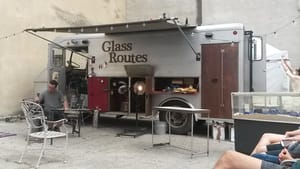Stay in the Loop
BSR publishes on a weekly schedule, with an email newsletter every Wednesday and Thursday morning. There’s no paywall, and subscribing is always free.
Creation and destruction
Fringe 2015: 'glass movement' by Glass Routes

I kicked off my Fringe Festival experience with glass movement by Glass Routes, a roving glassmaking show. The glass studio on wheels promised a physical creation, unlike many of the other shows I anticipate seeing. The festival program description also refers to “destruction, breaking conventional ideas and glass.” Since I grew up in Corning, New York, a small town with a long history of glassmaking, I am quite familiar with the process and the product. This festival performance intrigued me: Would it be that different from the work I have seen over the years in my hometown?
The Glass Routes crew parked their fire truck, converted by Chester County glass artist Kalen Erion into a mobile studio, in a lot off Elfreth's Alley. Seating for a dozen viewers faces the working area at a safe distance. The “stage” includes a table with an array of blown mugs, pitchers, and cups, all presumably the work of Glass Routes. A line of balloon-animal-like glass sculptures sits atop the truck. The driver’s-side paneling of the truck reveals a “glory hole” (as glassmakers call it), the opening to an active furnace, which in this case is attached to a forced air apparatus that provides the heated space required to keep the glass pliable. Two tables for working the glass stand near the glory hole, each at a different height. A case of sand resembling a fish tank contains shards of previous pieces, all a beautiful blue.
The Fringe catalog had promised a “live music accompaniment.” Instead, an iPod connected to speakers played Americana that felt neither old nor new. I had hoped that the glassblowing would be choreographed somehow with the music, or that the musicians might be inspired by the creation of the glasswork. Perhaps this varies by day. The music added a little extra to the atmosphere, though a live group would have contributed more.
No set structure
Maggie Gallen, a member of Glass Routes along with Kalen Erion and Justin Erion, narrated the activity and answered audience questions. Shortly after the official start time of the performance, I realized that there was no set structure to the “piece”; instead, it is an ongoing demonstration of the truck’s and the artists’ capacity. Two other unnamed Philadelphia-based glassblowers participated, bringing the crew count to five. Maggie explained that the group used air cooling rather than the usual computerized annealing kilns: Since the pieces are created to be destroyed immediately, there’s no need to use the more sophisticated finishing technique.
Maggie explained that the group used air cooling rather than the usual computerized annealing kilns: Since the pieces are created to be destroyed immediately, there’s no need to use the more sophisticated finishing technique.
I watched the crew make two pieces, each of which took about a half hour. The first glassblower, who was never introduced by name, created a mug, including a handle, with assistance for drizzling on decorative elements. As Maggie described the work, she noted that consumers often view glass as a product. The Glass Routes show brings the process itself out of the studio, with the ensemble work of the glassblower and his or her assistant constituting an improvised performance. The pair make decisions and respond to the unique atmospheric conditions, which affect the glass; the size of the gathered blob of glass being worked; and the action of the glory hole cover, which is heavy enough to swing closed unpredictably. The second piece was a handkerchief vase. Kalen himself acted as gaffer (the chief glassblower) for this creation, coiling hot glass tightly, which reminded a vocal audience member of clay, a medium in which she said she works.
Ending with a bang
The finale of each movement of the show is the destruction of the newly made glass, which is shattered into the sand-filled case. At least one viewer sitting near me loudly expressed discomfort with this aspect, despite the festival guide description's explicit mention of “destruction” taped into his notebook. This was certainly the most salient part of the show for me. The other viewers seemed unable to detach from the glass as a product or a piece of art in its own right.
I presume the artists anticipated this mismatch between the show’s reality and the audience’s expectations of how glass art should be treated: as items to be kept for posterity, whether in use or for preservation's sake. The process on display, meant to be celebrated and examined as a performance itself, ended up taking a backseat for these viewers, comfortable in their traditional paradigm that all physically created art pieces must endure the creation process.
What, When, Where
glass movement by Glass Routes. September 3-7, 2015. The Clay Studio, 137 North Second Street, Philadelphia. Part of the 2015 Philadelphia Fringe Festival. fringearts.com or 215-413-1318.
Sign up for our newsletter
All of the week's new articles, all in one place. Sign up for the free weekly BSR newsletters, and don't miss a conversation.

 Neil Bardhan
Neil Bardhan